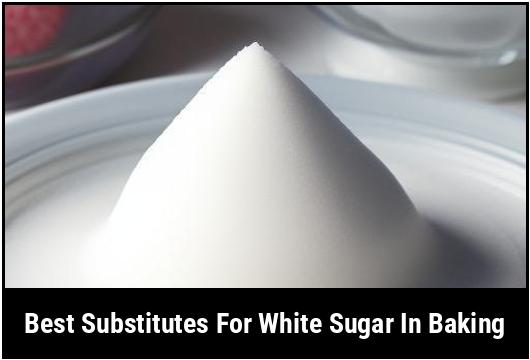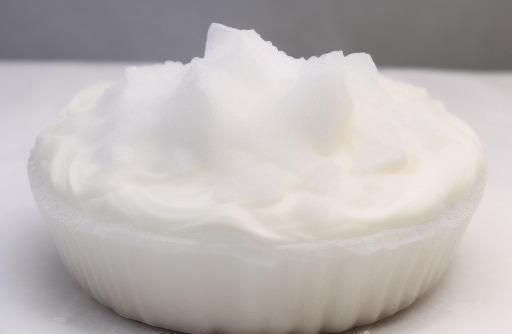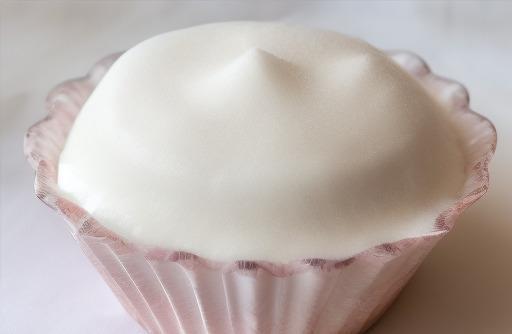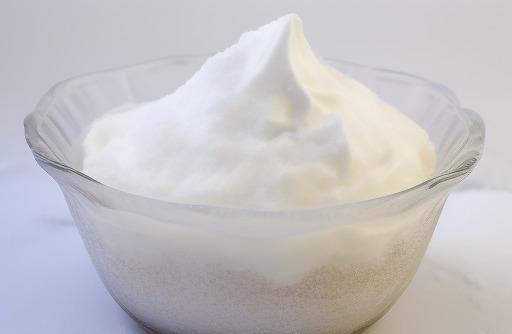Best Substitutes For White Sugar In Baking

When it comes to baking, sugar is an essential ingredient that adds sweetness, moisture, and texture to your favorite treats. However, many people are looking for alternatives to white sugar due to health concerns or dietary restrictions. Fortunately, there are numerous substitutes available that can provide the same sweetness and functionality as white sugar, without the negative effects. In this article, we will explore the best substitutes for white sugar in baking and how to use them effectively.
Key Takeaways
- White sugar can be replaced with a variety of substitutes in baking.
- Natural sweeteners like honey, maple syrup, and agave nectar can add flavor and moisture to baked goods.
- Alternative sugars, such as coconut sugar and date sugar, can provide a similar taste to white sugar.
- Artificial sweeteners can be used in moderation, but they may not provide the same texture and flavor as white sugar.
- When choosing a substitute for white sugar, consider the flavor, sweetness level, and moisture content of the sweetener.
Why You Need A Substitute For White Sugar In Baking
There are several reasons why you might want to use a substitute for white sugar in baking:
-
Health concerns: White sugar is high in calories and has been linked to various health problems, including obesity, diabetes, and heart disease. Using a substitute allows you to reduce your sugar intake and make healthier choices without sacrificing the sweetness in your baked goods.
-
Dietary restrictions: Some people have dietary restrictions that prevent them from consuming white sugar. This includes individuals following a vegan or paleo diet, as well as those with certain medical conditions.
-
Flavor enhancement: Substituting white sugar with alternative sweeteners can add a unique flavor profile to your baked goods. For example, using honey or maple syrup can impart a rich, caramel-like taste, while coconut sugar can add a subtle hint of coconut.
Types Of Substitutes For White Sugar In Baking

There are several types of substitutes for white sugar that can be used in baking. These include:
-
Natural sweeteners: Natural sweeteners are derived from plant sources and are often considered healthier alternatives to white sugar. Some common natural sweeteners used in baking include honey, maple syrup, agave nectar, and molasses. Natural sweeteners can add moisture and flavor to your baked goods, but it’s important to note that they may not provide the same texture and volume as white sugar.
-
Alternative sugars: Alternative sugars are minimally processed sweeteners that are made from natural sources. These sugars are often less refined than white sugar and retain some of their natural nutrients. Some popular alternative sugars used in baking include coconut sugar, date sugar, and stevia. Alternative sugars can be used at a 1:1 ratio with white sugar, making them a convenient option for baking.
-
Artificial sweeteners: Artificial sweeteners are chemically produced substances that mimic the taste of sugar but contain little to no calories. Examples of artificial sweeteners commonly used in baking include sucralose (Splenda), aspartame (Equal), and saccharin (Sweet’N Low). While artificial sweeteners can be used in baking, they may not provide the same texture and flavor as white sugar. Additionally, some individuals may have sensitivities or adverse reactions to artificial sweeteners.
Best Substitutes For White Sugar In Baking

Now let’s dive into the best substitutes for white sugar in baking:
-
Honey: Honey is a natural sweetener that adds a wonderful depth of flavor to baked goods. It contains antioxidants and has antimicrobial properties. When using honey as a substitute for white sugar, use ¾ cup of honey for every 1 cup of sugar. Since honey retains more moisture, reduce the amount of liquid in the recipe by ¼ cup. Honey tends to brown faster than white sugar, so you may need to reduce the oven temperature by 25°F and adjust the baking time accordingly.
-
Maple Syrup: Maple syrup is another natural sweetener that imparts a distinct flavor to baked goods. It is rich in minerals and antioxidants, making it a healthier choice than white sugar. When using maple syrup as a substitute, replace 1 cup of sugar with ¾ cup of maple syrup. Also, reduce the amount of liquid in the recipe by 3 tablespoons. Keep in mind that maple syrup can darken the baked goods, so decrease the oven temperature by 25°F and monitor the baking time.
-
Coconut Sugar: Coconut sugar is a natural sweetener derived from the sap of coconut palm trees. It has a similar taste to brown sugar, with a hint of caramel flavor. Coconut sugar can be used as a 1:1 replacement for white sugar in baking. It has a lower glycemic index compared to white sugar, which means it has a lesser impact on blood sugar levels.
-
Date Sugar: Date sugar is made by grinding dried dates into a coarse powder. It is a good source of fiber and minerals, making it a healthier alternative to white sugar. However, due to its coarse texture, date sugar may not dissolve completely in recipes that require a smooth texture. It works best in recipes where a subtle caramel flavor is desired, such as brownies and fruit-based baked goods. Use date sugar as a 1:1 substitute for white sugar.
-
Stevia: Stevia is a natural sweetener extracted from the leaves of the Stevia plant. It is much sweeter than white sugar, so a little goes a long way. Stevia can be used in baking, but it works best when combined with other sweeteners to achieve the desired taste and texture. You can find powdered stevia or liquid stevia extract, and the conversion ratio may vary depending on the brand. Follow the instructions on the packaging when using stevia as a substitute.
Choosing The Right Substitute For White Sugar In Baking

When choosing a substitute for white sugar in baking, consider the following factors:
-
Flavor: Each substitute has a distinct taste, so choose the one that complements your recipe. For example, honey adds a floral sweetness, while maple syrup provides a rich, earthy flavor. Coconut sugar has a caramel-like taste, and stevia is intensely sweet.
-
Sweetness level: Different sweeteners vary in sweetness. Some may be sweeter than white sugar, while others may be less sweet. Adjust the amount of sweetener accordingly to achieve the desired level of sweetness in your baked goods.
-
Moisture content: It’s important to consider the moisture content of the substitute when replacing white sugar. Substitutes like honey and maple syrup add moisture and may require adjustments to the recipe. Reduce the amount of liquid or increase the amount of dry ingredients to achieve the right consistency.
-
Browning and texture: Certain substitutes, such as honey and maple syrup, can cause baked goods to brown faster due to their natural sugars. Monitor the baking time and adjust the temperature accordingly. Additionally, some substitutes may alter the texture of the final product. Consider the desired texture and adjust the recipe as needed.
Cooking With Substitutes For White Sugar In Baking

When using substitutes for white sugar in baking, keep the following tips in mind:
-
Measure accurately: It’s important to measure the substitute accurately to ensure the right sweetness and consistency in your baked goods. Use measuring cups or a kitchen scale to measure the exact amount required.
-
Make adjustments: Substituting white sugar with alternative sweeteners may require adjustments to other ingredients in your recipe. Take note of the moisture content and adjust the liquid and dry ingredients accordingly to achieve the desired consistency.
-
Experiment: Baking is an art, and trying out different substitutes can lead to unique and delicious creations. Don’t be afraid to experiment with different sweeteners and combinations to find your perfect substitution for white sugar.
-
Combine sweeteners: In some cases, using a combination of different sweeteners can yield the best results. For example, combining coconut sugar with a liquid sweetener like honey or maple syrup can provide a balanced flavor and texture.
Recipes Using Substitutes For White Sugar In Baking

Here are a few delicious recipes that use substitutes for white sugar:
-
Honey-Sweetened Banana Bread:
-
Ingredients:
- 2 cups all-purpose flour
- 1 teaspoon baking soda
- ½ teaspoon salt
- 4 ripe bananas, mashed
- ½ cup melted unsalted butter
- ½ cup honey
- 2 large eggs
- 1 teaspoon vanilla extract
-
Instructions:
- Preheat the oven to 350°F (175°C) and grease a loaf pan.
- In a large bowl, whisk together the flour, baking soda, and salt.
- In a separate bowl, mix the mashed bananas, melted butter, honey, eggs, and vanilla extract.
- Pour the wet ingredients into the dry ingredients and mix until just combined.
- Pour the batter into the prepared loaf pan and bake for about 60 minutes or until a toothpick inserted into the center comes out clean.
- Allow the banana bread to cool in the pan for 10 minutes before transferring to a wire rack to cool completely.
-
-
Maple Syrup-Sweetened Oatmeal Cookies:
-
Ingredients:
- 1 cup rolled oats
- 1 cup all-purpose flour
- ½ teaspoon baking soda
- ½ teaspoon ground cinnamon
- ¼ teaspoon salt
- ½ cup unsalted butter, softened
- ½ cup maple syrup
- 1 large egg
- 1 teaspoon vanilla extract
- ½ cup raisins (optional)
-
Instructions:
- Preheat the oven to 350°F (175°C) and line a baking sheet with parchment paper.
- In a medium bowl, whisk together the oats, flour, baking soda, cinnamon, and salt.
- In a separate large bowl, cream the butter and maple syrup together until light and fluffy.
- Beat in the egg and vanilla extract until well combined.
- Gradually add the dry ingredients to the wet ingredients and mix until just combined.
- Fold in the raisins, if using.
- Drop rounded tablespoons of dough onto the prepared baking sheet.
- Bake for about 12-15 minutes or until the edges are golden brown.
- Allow the cookies to cool on the baking sheet for 5 minutes before transferring to a wire rack to cool completely.
-
-
Coconut Sugar-Sweetened Chocolate Brownies:
-
Ingredients:
- 1 cup unsalted butter
- 1 ½ cups coconut sugar
- ¾ cup unsweetened cocoa powder
- ½ teaspoon salt
- 1 teaspoon vanilla extract
- 3 large eggs
- 1 cup all-purpose flour
-
Instructions:
- Preheat the oven to 350°F (175°C) and grease a 9×9-inch baking pan.
- In a medium saucepan, melt the butter over low heat.
- Remove from heat and stir in the coconut sugar, cocoa powder, salt, and vanilla extract until well combined.
- Add the eggs, one at a time, beating well after each addition.
- Gradually add the flour and mix until just combined.
- Pour the batter into the prepared baking pan and smooth the top.
- Bake for about 25-30 minutes or until a toothpick inserted into the center comes out with a few crumbs.
- Allow the brownies to cool completely in the pan before cutting into squares.
-
Storage And Shelf Life Of Substitutes

The storage and shelf life of substitutes for white sugar vary depending on the type of substitute:
-
Natural sweeteners: Honey, maple syrup, agave nectar, and molasses can be stored at room temperature in a cool, dark place for several months. However, make sure to check for any signs of spoilage before using.
-
Alternative sugars: Coconut sugar, date sugar, and stevia have a long shelf life and can be stored in airtight containers in a cool, dry place for up to a year.
-
Artificial sweeteners: Artificial sweeteners usually have a long shelf life and can be stored in their original packaging or airtight containers. Follow the manufacturer’s instructions for proper storage and usage.
Conclusion
Finding the best substitute for white sugar in baking allows you to enjoy your favorite treats without compromising on taste or health. Natural sweeteners like honey and maple syrup can provide additional flavor and moisture to your baked goods, while alternative sugars like coconut sugar and date sugar offer a similar taste to white sugar. Artificial sweeteners can also be used, but they may not provide the same texture and flavor. When choosing a substitute, consider the flavor, sweetness level, and moisture content to achieve the desired results. So go ahead and experiment with these substitutes to create delicious, healthier baked goods that everyone can enjoy.
Pro Tip: When using a liquid sweetener like honey or maple syrup as a substitute for white sugar, reduce the amount of liquid in the recipe by ¼ cup to compensate for the additional moisture.
FAQS
What Are Some Natural Sweeteners That Can Be Used As A Substitute For White Sugar In Baking?
Some popular natural sweeteners that can be used as a substitute for white sugar in baking include honey, maple syrup, agave nectar, coconut sugar, and stevia. Each of these sweeteners varies in flavor and texture, so it’s important to experiment to find the one that works best for your recipe.
How Do I Substitute Honey For White Sugar In Baking?
When using honey as a substitute for white sugar in baking, use 3/4 cup of honey for every 1 cup of white sugar, and reduce the liquid in your recipe by 1/4 cup. Honey is sweeter than sugar, so you’ll need to use less of it. Additionally, it can cause baked goods to brown faster, so you may need to reduce your oven temperature and bake your recipe for a shorter time.
Can I Use Fruit Puree As A Substitute For White Sugar In Baking?
Yes, fruit puree can be used as a substitute for white sugar in some baked goods. Apple sauce, mashed bananas, and pumpkin puree are all popular choices. When using fruit puree as a substitution, use 3/4 cup of puree for every 1 cup of white sugar, and reduce the liquid in your recipe by 1/4 cup.
Can I Use Artificial Sweeteners As A Substitute For White Sugar In Baking?
Yes, some artificial sweeteners can be used as a substitute for white sugar in baking, but they may not give you the same results as traditional sugar. Stevia, for example, is a popular natural sweetener that can be used in baking, but it can have a slightly bitter aftertaste. Splenda is another artificial sweetener that can be used, but it doesn’t brown in the same way that sugar does, so it may not work in recipes that rely on caramelization for flavor.
Are There Any Health Benefits To Using Natural Sweeteners Instead Of White Sugar In Baking?
Yes, natural sweeteners such as honey, maple syrup, and coconut sugar are often considered to be healthier alternatives to white sugar because they contain vitamins and minerals that are not found in processed sugar. Additionally, some studies have suggested that they may have a lower glycemic index, meaning that they can help regulate blood sugar levels. However, it’s important to remember that they are still sweeteners and should be used in moderation.
Sources
About the Author Jenny
I'm Jenny, a housewife with an unwavering passion for food. My culinary journey began with my grandmother's kitchen, and it's now a full-fledged food blog. I've turned my love for cooking into a creative outlet, sharing recipes and stories with a global community of fellow food enthusiasts. It's proof that being a housewife can also mean pursuing your passions and savoring life's delectable moments.
